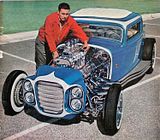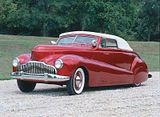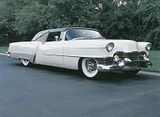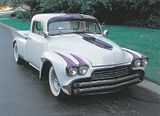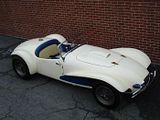Kustoms

|
Kustoms are modified cars from the 1930s and early 1960s done in the customizing styles of that time period. The usage of a "K" for "Kustom" rather than a "C", is said to have originated from car builder George Barris (although it is not confirmed). These cars can also be referred to as custom cars, leadsleds or sleds. A kustom can range from a mild Kustom to a full kustom to a bomb.
In the late 1930s, as roadster and coupe driving hot rodders started families, they suddenly needed reliable cars that could transport more than two people. Thus, custom cars were born passenger automobiles turned into one-of-a-kind art pieces reflecting the aesthetic sensibilities of their owners and builders. Today, the mild-to-wild styles and techniques that grew out of the custom car movement might seem like they've been around forever. Fortunately, a number of top-notch builders are keeping these classic elements alive. This style that makes a Kustom a Kustom generally consists of, but it not limited to starting with a 2-door coupe. Lowering the suspension. Chopping down the roof line, (usually chopped more in the rear to give a "raked back" look, B-pillars are also commonly leaned to enhance this look). Sectioning and/or channeling the body, (removing a section from the center of the body). Certain pieces of side trim are usually removed or "shaved" to make the car look longer, lower and smoother. Often times bits and pieces of trim from other model cars, are cut, spliced and added to give the car a totally new and interesting "line" to lead the eye in the direction that the Kustomizer wishes it to go. Door handles are also "shaved" as well, electric solenoids or cables are installed. Buttons are installed in hidden locations and used to open the doors. Trunk lids and other pieces of the body can also be altered in this matter. "Lakes pipes" were another Kustom main stay, long or short chrome pipes that run back from behind the front wheels wells. The have either one of three removable end plugs for running straight through with open exhaust. Side pipes are similar but do not include removable plugs, "Bellflower" tips are similar but run from the rear wheel well back under the bumper, a style that emerged in the Bellflower, California area in the early '60s. It is an up-spoken rule of sorts that a Kustom will have whitewall tires, most authentic being bias ply style tires. The width of the whitewall denotes the era that the particular car hearkens to. For example, a Kustom built in a '40s style will typically have true "wide Whites" which are 3 inches or more in width, where the white rubber extends behind the rim of the wheel, this style is period correct for Kustoms up to the mid '50s. From the mid to late '50s, a narrower (but still wide) extending to the rim of the wheel. In 1956, GM had a concept car called "Biscayne" (styling elements that were later used on Corvettes, '57 Chevrolets, and Corvairs). This car featured some new high tech looking tyres that had only a very thin stripe of whitewall rubber. By 1958, Cadillac starts selling cars with these type of "Skinny Whites" or "Inch walls" they were an instant hit and all the rage with the Kustom Krowd. This style of thinner 1 in, 1.5 in, 1.3 in, 3/8 in, or 5/8 in whitewall continued to be popular into the '60s and are still common on some newer cars today. Traditionally, "Lead", (a mixture of 70% lead and 30% tin) is used in bodywork instead of modern polyester fillers or fiberglass, after the metal shaping is done to prepare for paint. "Leading" is old school (how it was done in the day). A true Kustom "Lead Sled", which was started in the '50s to imply a large, slow lead-filled car that was all flash and could not hold its own at the races. This was sometimes not the case however and certain Kustoms packed some serious punch under the hood. Today, however calling someone's car a "Lead Sled" will generally be taken as a compliment. The head and tail lights of a true Kustom may or may not be the original ones manufactured with the car. Some popular swaps would be putting Oldsmobile or Buick headlights in another model for example. Headlights, tail lights, antenna are also subject to term and act called "Frenching", where the object is cut from the body, a "box" in the shape of the item is fabricated and welded into the original hole. The part is then installed back into the "Frenching Pocket" giving it a look of being recessed into the body. Grilles are often changed on lead sleds as well. Some owners use pieces of other grills to Kustomize their own. For example, using a DeSoto grill in a '50 Mercury, or a LaSalle (Cadillac) grill in a '36 Ford, two of the most recognized and classic combinations of all time. "Flipper" style hubcaps are popular on Kustoms, such as '57 Dodge Lancer (4 bars) , '56 Oldsmobile Fiesta (3 bars) , '59 Dodge lancer or "Crabs" as they are said to resemble a crab, Other such as '57 and '49 Cadillac hubcaps are also acceptable and referred to as "Sombreros", '57 Plymouth "cones", etc. There were also other popular styles that were purely after market and never came factory stock on another car, like "Hollywood" flippers, or "Crossbars" for example. These pages feature the work of some of the men who keep making custom car history, and features dozens of chopped, sectioned, shaved, decked, flamed, frenched, nosed, lowered, scalloped, striped, and slammed Caddies, Mercs, Buicks, shoebox Fords, Chevys, and Oldsmobiles that exemplify traditional custom car design. |
|
||||||||||||||||||||||||||||||||||||||||||||||||||||||||||||||||||||||||||||||||||





